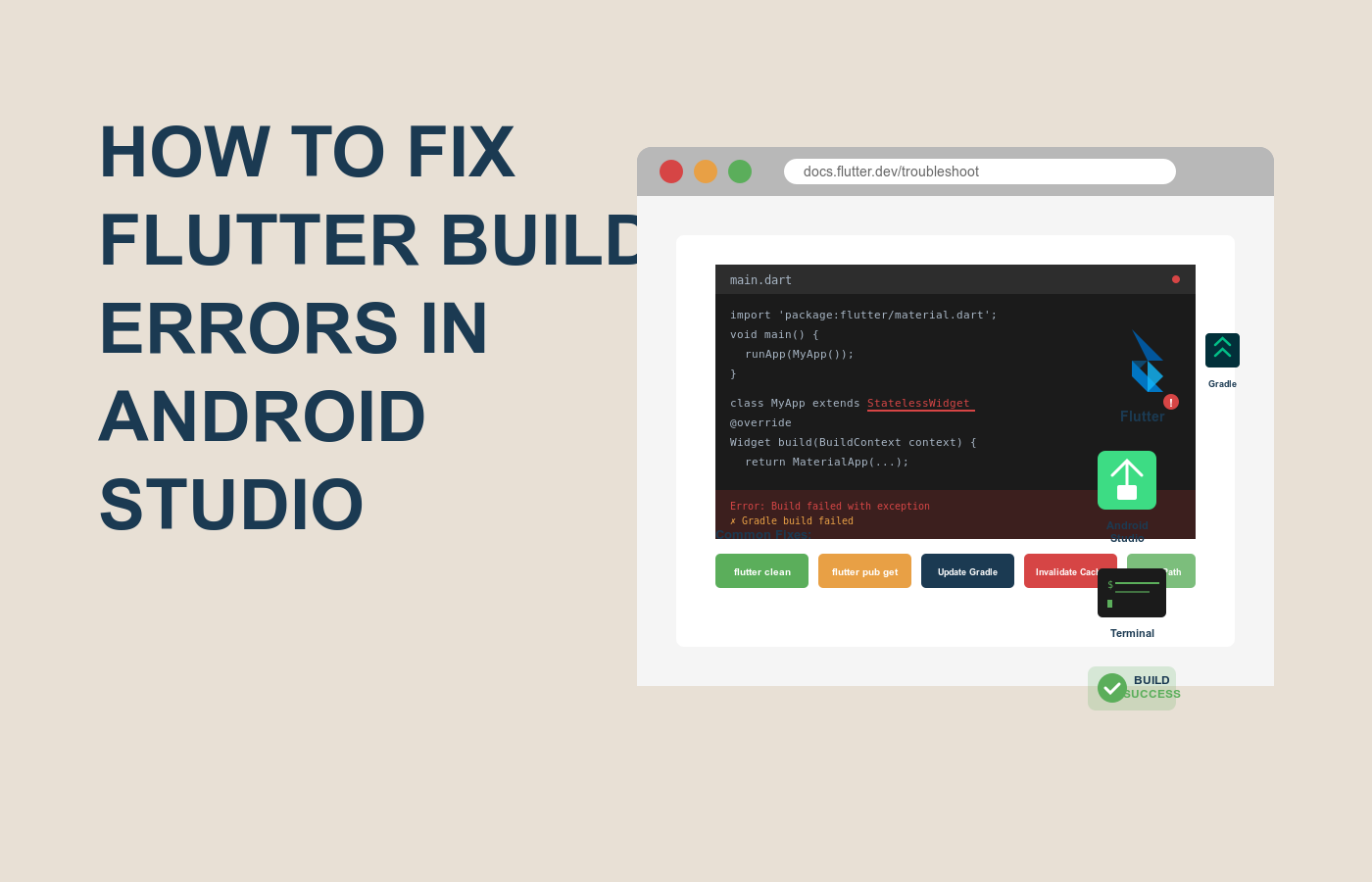How to Fix Flutter Build Errors in Android Studio

Why Flutter Build Errors Are a Common Struggle
If you’re a Flutter developer, chances are you’ve faced build errors in Android Studio at least once. It’s one of the most frustrating moments—your code looks fine, but the app just won’t build. The console throws strange red messages, Gradle takes forever, and you’re left wondering what went wrong.
This issue matters because Flutter is one of the fastest-growing frameworks in 2025, powering cross-platform apps for startups and enterprises alike. But when Flutter build errors stop your project, it delays productivity, affects delivery, and can even discourage beginners.
The good news? Most build errors follow predictable patterns. Once you understand the common causes and fixes, you can solve them quickly without wasting hours googling stack traces.
In this guide, we’ll break down:
- The most common reasons why Flutter build errors happen in Android Studio.
- Step-by-step fixes you can apply immediately.
- A comparison of common error types and their solutions.
- Extra tips to prevent future build errors.
By the end, you’ll not only fix your current issue but also build confidence in troubleshooting Flutter projects.
Why Flutter Build Errors Happen in Android Studio
Before we dive into solutions, let’s quickly understand why build errors occur. Flutter is a hybrid framework that relies on both Dart code and native Android dependencies (Gradle, SDKs, plugins). When any of these layers break, Android Studio shows build errors.
Here are the most common causes:
- Outdated Flutter SDK – Using an old Flutter version that conflicts with updated packages.
- Gradle or Android SDK issues – Mismatched Gradle versions, corrupted caches, or missing SDK components.
- Package conflicts – When two dependencies require different versions of the same library.
- Incorrect environment setup – Missing PATH variables, outdated JDK, or misconfigured Android Studio settings.
- Obsolete plugins – Old Flutter/Android Studio plugins causing compatibility errors.
- Emulator/device issues – Sometimes, the problem lies with the connected device or emulator.
The key takeaway: build errors usually occur because Flutter and Android Studio rely on multiple moving parts, and one mismatch can break everything.
Step-by-Step Guide: Fixing Flutter Build Errors
Let’s now go through practical fixes. You don’t need to try all of them—just identify your error message and apply the right step.
Step 1: Clean and Rebuild the Project
The simplest but most effective first step. Often, cached files cause conflicts.
Steps:
- Run:
flutter clean - Delete the
.gradleandbuildfolders (optional, but helps). - Run:
flutter pub get - Rebuild the app in Android Studio.
Example: Many “Gradle task assembleDebug failed” errors are solved just by cleaning and fetching packages again.
Step 2: Update Flutter SDK and Plugins
Outdated SDK or plugins often trigger build errors.
Steps:
- Run:
flutter upgrade - Update Dart/Flutter plugins in Android Studio:
- Go to File → Settings → Plugins → Updates.
- Check Flutter doctor:
flutter doctorFix any issues shown (missing SDKs, licenses, etc.).
Step 3: Fix Gradle & Android SDK Issues
A lot of errors come from Gradle misconfigurations.
Steps:
- Open
android/build.gradle. - Update the Gradle distribution URL, e.g.:
distributionUrl=https\://services.gradle.org/distributions/gradle-8.0-all.zip - Update Android Gradle Plugin in
build.gradle:classpath 'com.android.tools.build:gradle:8.0.2' - Sync Gradle again.
Example: If you see Unsupported class file major version errors, it usually means your Gradle or JDK version is mismatched.
Step 4: Resolve Dependency Conflicts
Sometimes, packages require different versions of the same dependency.
Steps:
- Check
pubspec.yamlfor dependency versions. - Run:
flutter pub outdatedThis shows outdated packages. - Update dependencies to the latest compatible version.
- If needed, add dependency overrides in
pubspec.yaml:dependency_overrides: intl: ^0.18.0
Example: Errors like Because xyz depends on intl ^0.17.0 and abc depends on intl ^0.18.0, version solving failed. can be solved with overrides.
Step 5: Fix JDK and Environment Variables
Flutter requires the right JDK version. If Android Studio is using an incompatible JDK, you’ll get build errors.
Steps:
- Install JDK 17 (recommended for Flutter 3.19+).
- In Android Studio, go to File → Project Structure → SDK Location.
- Point it to the correct JDK folder.
- Update environment variables:
export JAVA_HOME=/path/to/jdk export PATH=$JAVA_HOME/bin:$PATH
Example: Errors like Unsupported Java. Your build is currently configured to use Java 11 often mean you need JDK 17.
Step 6: Accept Android Licenses
Sometimes builds fail because you haven’t accepted Android licenses.
Run:
flutter doctor --android-licenses
Accept all licenses when prompted.
Step 7: Check Emulator/Device Setup
Sometimes the build is fine, but the error comes from the emulator.
Steps:
- Restart your emulator or try a physical device.
- Ensure your emulator runs the correct API level (e.g., API 33 for latest builds).
- Clear AVD data if needed.
Comparison Table: Common Errors vs. Fixes
| Error Message | Cause | Fix |
|---|---|---|
| Gradle task assembleDebug failed | Cached build files | Run flutter clean + rebuild |
| Unsupported class file major version error | Wrong JDK/Gradle version | Install JDK 17 + update Gradle |
| Plugin version mismatch | Outdated Flutter/Android plugin | Upgrade plugins + Flutter SDK |
| Dependency version solving failed | Conflicting packages in pubspec.yaml | Update dependencies + overrides |
| Emulator build fails | Wrong emulator config | Use correct API level or real device |
Extra Tips to Avoid Future Build Errors
- Always run
flutter pub upgradeonce a week to stay updated. - Use version control (Git) so you can roll back if dependencies break.
- Keep Android Studio and Flutter SDK aligned with the latest stable releases.
- Document the errors you encounter—chances are, they’ll repeat.
- Join Flutter forums and GitHub issues to see if others face similar build errors.
We already explored common causes and some solutions, but let’s now go deeper into practical troubleshooting steps with examples.
1. Resolve Gradle Sync Issues
Gradle is the build system behind Android Studio, and Flutter depends on it heavily. If you see errors like “Gradle sync failed” or “Could not resolve dependency”, here’s how to fix them:
- Check Gradle version
- Open
android/gradle/wrapper/gradle-wrapper.properties. - Update the distribution URL to a compatible version. For example:
distributionUrl=https\://services.gradle.org/distributions/gradle-7.5-all.zip
- Open
- Update Android Gradle plugin
- In
android/build.gradle, make sure you’re using a supported plugin version:classpath 'com.android.tools.build:gradle:7.4.2'
- In
- Re-sync Gradle
- In Android Studio, click File > Sync Project with Gradle Files.
- Then run:
flutter clean flutter pub get flutter build apk
Example: If your project was using an outdated Gradle (6.x), upgrading to Gradle 7.x often solves dependency issues.
2. Fix “Execution failed for task” Errors
Sometimes during builds, you’ll see errors like:
Execution failed for task ':app:compileDebugJavaWithJavac'.
Possible fixes:
- Ensure Java JDK version matches Android Studio requirements (Java 11 is usually safe).
- Delete the
.gradleandbuildfolders, then rebuild. - Run with more logs:
flutter build apk -v(The-vflag helps you pinpoint the issue.)
3. Address Flutter Plugin Issues
Many errors come from incompatible plugins. If you see errors like:
Because app depends on xyz_plugin >=3.0.0 which requires SDK version >=2.18.0 <3.0.0, version solving failed.
Fix:
- Update your Flutter SDK with:
flutter upgrade - If the plugin is outdated, check its pub.dev page for the latest version.
- Replace abandoned plugins with maintained alternatives.
Example:flutter_webview_pluginis outdated → usewebview_flutter.
4. Handle “App not installed” After Build
If your APK builds but doesn’t install, the cause could be:
- Conflicting package name: Ensure
applicationIdinapp/build.gradleis unique. - Old APK already installed: Uninstall the old app manually or run:
adb uninstall com.example.myapp - Invalid signing configuration: If you’re using release mode, ensure your keystore is properly set in
key.properties.
5. Out of Memory or Slow Build
Large Flutter apps can sometimes take forever to build or crash due to memory limits.
Fix:
- In
gradle.properties, add:org.gradle.jvmargs=-Xmx4096M - This allocates more memory (4 GB) to Gradle. Adjust according to your system RAM.
Comparison Table: Common Build Errors in Flutter
| Error Type | Cause | Fix |
|---|---|---|
| Gradle sync failed | Outdated Gradle version / plugin mismatch | Update Gradle & Android plugin |
| Execution failed for task | Wrong JDK version / corrupted build files | Install correct JDK, delete build folders |
| Plugin dependency version conflict | Outdated Flutter or plugin version | Upgrade Flutter & plugins |
| App not installed after build | Conflicting package ID / signing issue | Change package ID, fix signing config |
| Slow build / memory errors | Low system resources | Increase Gradle JVM memory |
Extra Tips for Debugging Flutter Build Errors
- Use Flutter Doctor Regularly
Run:flutter doctor -vThis checks your environment and highlights missing dependencies. - Enable Multidex for Large Projects
If you see errors likeToo many methods, enable multidex inapp/build.gradle:defaultConfig { multiDexEnabled true } - Use Stable Channel for Production
Avoid unexpected issues by switching to Flutter’s stable channel:flutter channel stable flutter upgrade - CI/CD Integration
If your builds succeed locally but fail in CI/CD, check environment variables (JAVA_HOME, ANDROID_HOME) and Gradle cache.
FAQs: Fixing Flutter Build Errors in Android Studio
Q1. Why does my Flutter build keep failing in Android Studio?
A: Most failures happen due to mismatched Gradle, outdated dependencies, or incorrect SDK versions. Updating Flutter, Gradle, and plugins usually resolves it.
Q2. How do I fix plugin incompatibility errors in Flutter?
A: Update the plugin to its latest version from pub.dev. If the plugin is abandoned, replace it with an alternative package.
Q3. Can I fix build errors without deleting my project?
A: Yes, in most cases you just need to run flutter clean and flutter pub get. Deleting the project is unnecessary.
Q4. Which JDK version is best for Flutter builds?
A: JDK 11 works well for most Flutter projects in Android Studio. Avoid JDK 17 unless specifically required.
Q5. My app builds but won’t install. What should I do?
A: Check for duplicate package names, uninstall previous versions, or correct your signing config.
Conclusion
Flutter is a powerful framework, but build errors in Android Studio can feel overwhelming, especially for beginners. Most of these issues come down to outdated Gradle, plugin conflicts, or environment misconfiguration.
By following the step-by-step fixes above — updating Gradle, checking dependencies, fixing plugin errors, and optimizing builds — you’ll solve 90% of the problems you face.
Don’t get discouraged. Debugging is part of being a developer, and every error you solve makes you better.
Start today: run flutter doctor, clean your build, and update your plugins. Within minutes, you’ll likely have a working build again.
#Flutter #AndroidStudio #FlutterBuildErrors #MobileDevelopment #AppDevelopment #Gradle #Dart


2 Responses